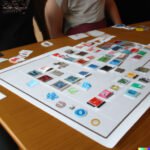The enduring charm and allure of wooden classic board games have captivated generations of players, both young and old. In the midst of a digital age, the tradition of physical board games remains an important aspect of leisure and entertainment. As we delve into the history, benefits, craftsmanship, and modern adaptations of these timeless games, it becomes clear that wooden classic board games hold a special place in our hearts and homes.
Since ancient times, wooden materials have been integral to the creation and evolution of beloved board games. From ancient civilizations to modern societies, the use of wood in crafting game boards and pieces has played a crucial role in shaping the experience of playing these cherished games. The tactile experience and sensory engagement offered by wooden game pieces add a unique dimension to gameplay that cannot be replicated in digital formats.
As we explore the world of wooden classic board games, it becomes evident that they offer more than just entertainment. The cognitive and social benefits of playing physical board games are well-documented, providing opportunities for strategic thinking, problem-solving, and meaningful social interactions. This enduring appeal has made wooden classic board games an essential cornerstone for family gatherings and social bonding activities throughout history.
History of Wooden Classic Board Games
The history of wooden classic board games dates back centuries, with evidence of ancient civilizations playing games on wooden boards. One of the earliest examples of a wooden board game is Senet, an ancient Egyptian game that was played on a flat, wooden board. Other early iterations of wooden board games include the Indian game Pachisi and the Chinese game Go, both of which utilized intricately carved wooden boards and pieces.
Wood has been a significant material in the development of board games due to its durability and versatility. In many cultures, wood was abundant and easily accessible, making it an ideal choice for crafting game boards and pieces. The use of wood also added a tactile element to gameplay, enhancing the overall experience for players.
The popularity of wooden classic board games continued to grow over the centuries, with iconic games such as chess and backgammon emerging as cultural staples. These games were often handcrafted by skilled artisans, resulting in beautifully designed and intricately detailed game sets that are still treasured today. The historical significance of wooden board games cannot be overstated, as they have not only provided entertainment but also served as important artifacts documenting various aspects of human culture and society.
Benefits of Playing Wooden Classic Board Games
Wooden classic board games have been enjoyed for generations and continue to hold a special place in the hearts of many enthusiasts. The tactile experience and sensory engagement of wooden game pieces offer numerous benefits beyond mere entertainment. Playing physical board games, especially those made of wood, can have substantial cognitive and social advantages.
One of the key benefits of playing wooden classic board games is the cognitive stimulation they provide. These games often require strategic thinking, problem-solving, and decision-making skills. Whether it’s calculating moves in chess or planning a winning strategy in backgammon, players are constantly exercising their brains while having fun. This mental stimulation can be particularly beneficial for children as they develop critical thinking and analytical skills.
In addition to cognitive benefits, wooden classic board games also promote social interaction and communication. When people gather around a wooden game board, they engage in face-to-face interactions, fostering meaningful connections and relationships. Whether it’s friendly banter during a game of Scrabble or the teamwork involved in cooperative games like Pandemic, these experiences have a positive impact on social development and interpersonal skills.
Furthermore, the sensory experience of playing with wooden game pieces adds another dimension to the enjoyment of these classic games. The smooth texture and natural feel of wood enhance the overall gaming experience, making it more pleasurable and engaging for players of all ages.
| Benefits | Advantages |
|---|---|
| Cognitive Stimulation | Improves critical thinking and problem-solving skills |
| Social Interaction | Promotes face-to-face communication and interpersonal skills |
| Sensory Experience | Enhances overall gaming experience with natural textures |
Top Wooden Classic Board Games
Wooden classic board games have stood the test of time, providing entertainment and social interaction for generations. From ancient games like Mancala to modern favorites like Chess and Scrabble, these timeless games continue to captivate players of all ages.
The appeal of wooden board games lies in their tactile experience, nostalgic charm, and the craftsmanship of the game pieces. In this section, we will explore some of the most beloved wooden classic board games that have left a lasting impression on players around the world.
Chess
Chess is a strategic game that has been played for centuries, with its origins dating back to India in the 6th century. The game’s iconic wooden board and intricately carved wooden pieces have become synonymous with intellectual competition and artistic expression. The tactile sensation of moving wooden chess pieces across the checkered board adds an extra layer of engagement to the gameplay experience.
Backgammon
Originating in Persia over 5,000 years ago, Backgammon has been enjoyed by countless players throughout history. Its distinctive wooden board with intricate inlaid designs and smooth wooden dice cups evoke a sense of tradition and elegance. The satisfying sound of dice being rolled on a wooden surface adds to the overall appeal of this classic game.
Go
Go is an ancient Asian strategy game that dates back over 2,500 years. Its simple yet profound gameplay has made it an enduring classic. The traditional wooden Go board and smooth stone pieces are integral to the game’s aesthetic and strategic allure. Each move involves placing a stone on intersecting lines, resulting in a visually captivating pattern that evolves throughout the game.
These top wooden classic board games not only offer entertainment but also serve as cultural artifacts that reflect the traditions and craftsmanship of different societies. Their enduring popularity speaks to the timeless appeal of physical gameplay experiences in an increasingly digital world.
Craftsmanship and Durability
Wooden classic board games are not only cherished for their nostalgic appeal and entertaining gameplay but also for their exceptional craftsmanship and durability. Crafted from high-quality wood, these game sets are built to withstand the test of time, making them a worthy investment for generations to come. The attention to detail and precision in creating wooden game boards and pieces is a testament to the artistry and dedication of skilled artisans.
The use of wood in classic board games dates back centuries, with early civilizations utilizing this natural material for entertainment and strategic play. From the intricate carvings on chess pieces to the smooth finish of dice and playing pieces, wooden game sets showcase the timeless beauty of craftsmanship. The tactile experience of handling wooden game pieces adds a sensory dimension to gameplay that cannot be replicated by electronic or plastic versions.
In addition to their aesthetic appeal, wooden classic board games are renowned for their durability. Unlike flimsy cardboard or plastic components that may wear down over time, well-crafted wooden game sets can endure frequent use without losing their charm or functionality.
This longevity ensures that these beloved games can be enjoyed for years, making them a sustainable alternative to disposable entertainment options. Whether displayed as decorative pieces or passed down as heirlooms, wooden classic board games hold both historical value and practical appeal in today’s gaming landscape.
Modern Twists on Classic Wooden Board Games
In the age of technology and digital gaming, the appeal of wooden classic board games remains strong. However, that doesn’t mean that these traditional games are stuck in the past. In fact, many designers and game enthusiasts have found creative ways to put a modern twist on classic wooden board games, breathing new life into beloved favorites.
One way this is achieved is through the incorporation of new themes and storylines into classic wooden board games. By adding new elements such as unique characters, settings, and challenges, designers are able to refresh these timeless games without losing their nostalgic charm. This not only appeals to long-time fans of the games but also attracts a new generation of players who may be more interested in contemporary themes.
Another approach to modernizing wooden classic board games involves adapting them for different age groups or skill levels. By creating variations that cater to specific demographics, such as children or avid gamers, these timeless games can continue to be enjoyed by people of all ages and interests. For example, simplified versions of chess or strategic variations of checkers can make these classics more accessible and engaging for a wider audience.
Furthermore, technological advancements have allowed for the integration of digital elements into wooden classic board games. From interactive game pieces with embedded sensors to companion apps that enhance gameplay with sound effects and animations, these innovations create a hybrid gaming experience that combines the tactile feel of wooden pieces with the excitement of modern technology. By embracing these modern twists on classic wooden board games, enthusiasts can honor tradition while embracing innovation.
DIY Wooden Board Game Projects
Wooden classic board games have a timeless appeal that continues to attract people of all ages, even in the age of digital technology. One way to celebrate this tradition is by creating your own DIY wooden board game projects. These projects allow enthusiasts to customize their own game sets and personalize the gaming experience. Here are some ideas and tips for creating homemade wooden board games:
- Choose the right game: Before starting your DIY project, consider which wooden classic board game you want to recreate. Whether it’s chess, checkers, or any other game, make sure to choose one that you enjoy and have a personal connection with.
- Gather materials: Once you’ve chosen a game, gather all the necessary materials for your project. This may include wood for the game board, pieces or tokens, paint or stain, and any additional decorative elements you want to incorporate.
- Customize the design: Get creative with the design of your homemade wooden board game. Consider adding unique embellishments or personal touches to make it truly your own. You can also experiment with different wood finishes to achieve the look you desire.
Creating your own wooden board game not only allows you to showcase your creativity and craftsmanship but also provides an opportunity to bond with friends and family during the process. Additionally, DIY wooden board games can be cherished as meaningful keepsakes or gifts for loved ones.
Whether you’re a seasoned woodworker or new to crafting, embarking on a DIY wooden board game project can be a rewarding and enjoyable experience for any enthusiast of classic board games. By preserving the tradition of physical board games through handmade creations, we honor the history and cultural significance of these beloved games.
Celebrating the Art of Wooden Gaming
In conclusion, wooden classic board games continue to hold a special place in the hearts of many enthusiasts, offering a timeless appeal that transcends generations. As we navigate through the digital age, it is important to recognize and preserve the tradition of physical board games, particularly those crafted from wood. The tactile experience and sensory engagement of wooden game pieces provide a unique and irreplaceable element to the gaming experience, making them an invaluable part of our cultural heritage.
The history of wooden classic board games is rich and diverse, with origins that can be traced back centuries. The significance of wooden materials in the early development of board games cannot be understated, as they have played a vital role in shaping the evolution and popularity of these timeless pastimes. Additionally, the craftsmanship and durability of wooden board games set them apart from their plastic or electronic counterparts, ensuring that they remain cherished heirlooms for years to come.
As designers continue to explore contemporary adaptations and variations of traditional wooden board games, it is evident that the art of wooden gaming is not only being preserved but also celebrated in new and innovative ways. Whether through modern twists on classic games or DIY projects that allow individuals to create their own custom wooden game sets, there is a renewed sense of appreciation for the beauty and aesthetic appeal of wooden game boards and pieces.
Ultimately, the cultural significance and nostalgia associated with wooden classic board games will continue to endure, serving as a reminder of the enduring charm and timeless allure of these beloved pastimes.
Frequently Asked Questions
What Are the Most Popular Classic Board Games?
The most popular classic board games include Chess, Monopoly, Scrabble, and Clue. These games have stood the test of time and continue to be favorites among both children and adults.
What Is the Oldest Board Game That Still Exists?
Senet is considered to be the oldest board game that still exists today. Dating back to ancient Egypt, this game has been played for over 5,000 years and is a testament to the enduring appeal of board games.
What Is One of the Oldest and Most Popular Board Games?
One of the oldest and most popular board games is Go. Originating in China over 2,500 years ago, Go has a rich history and remains widely played today in various parts of the world. Its strategic depth continues to captivate players globally.

I love playing all kinds of games – from classics like Monopoly to modern favourites like Ticket to Ride.
I created this blog as a way to share my love of board games with others, and provide information on the latest releases and news in the industry.





